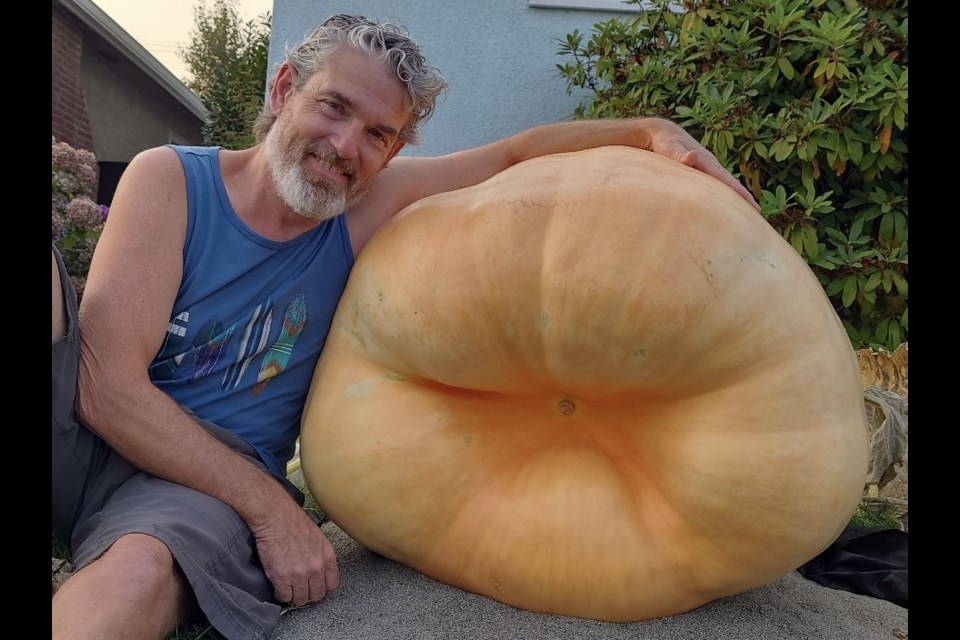Will Theodore the rhinoceros eat a 350-pound pumpkin? Will he “horn” it and use it as a plaything?
Visitors to the Greater Â鶹´«Ã½Ó³»Zoo will be able to find out on Saturday, Oct. 7, when New West resident Scott Loewen delivers a giant pumpkin to the zoo in Aldergrove. Each year, the Sapperton resident grows a giant pumpkin and checks another item off his pumpkin bucket list – and this year’s challenge is to feed a giant gourd to an animal.
Loewen contacted the zoo about feeding this year’s 350-or-so-pound pumpkin to one of its animals, and zoo staff immediately suggested Theodore (Theo), a five-year-old Southern White Rhinoceros. Loewen can’t wait to see how Theo reacts.
“I want to see the pumpkin get horned,” he laughed. “The rhino can stick his horn right in it and lift his head – that is what I’m hoping happens.”
While rhinos may have big appetites, zoo staff told Loewen it’s unlikely Theo will eat the whole pumpkin and that he’ll just play with it instead.
“Perfect!” Loewen said. “I just want to see him destroy it, get his horn in it and lift it up over his head. That’s all I want to see. If he’s going to take a few bites, great, but the fun is watching him use it as a play toy. He will move a 350-pound pumpkin around like it’s a little Lego piece, right?”
After buying some Dill’s Atlantic Giant Pumpkin seeds a few years ago, Loewen grew Bertha, a 130-pound pumpkin, in 2020.
The following year’s harvest yielded Goliath, who weighed in at 560 pounds, and David, a 130-pound pumpkin. Loewen recruited carver Bruce Waugh to carve Goliath in time for Halloween 2021.
Last year, Loewen, with a little help from some friends, transported his 500-pound pumpkin, Jabba, to Buntzen Lake in Anmore, where he scooped out the insides, donned pirate attire, hopped inside the pumpkin and took Jabba for a little paddle on the lake.
When Loewen started growing this year’s pumpkin, he named it Kamala – the Ugandan Giant in honour of his favourite wrestling character from the 1980s. Because Kamala “lived a life of excess,” Loewen decided to “go all in and fertilize the hell” out of this year’s pumpkin to see how big it could grow.
Turns out, it hasn’t been a great year for pumpkins, and this year’s gourd is significantly smaller than those in past years. But, as luck would have it, it’s the perfect size for a rhinoceros.
Because this year’s pumpkin plant started to get soft and mushy, Loewen cut the giant fruit from the vine to prevent it from rotting too early. Now, he’s coddling Kamala to ensure he can deliver his promised pumpkin to the Greater Â鶹´«Ã½Ó³»Zoo on Oct. 7.
“I am really protective of it,” Loewen said. “I don’t want some raccoon or rat or something to dig a hole in it, or some kids to roll it down a steep hill in New West or somebody to get in there and do something to it. I’ve got it under a tarp and blanket and stuff. I’m just taking care of it. Always looking at it and making sure there’s nothing getting in there.”
On Oct. 7, Loewen will pack up the pumpkin and head to Krause Berry Farms in Langley for its annual not to weigh Kamala but to support his fellow pumpkin pals. From there, joined by his kids and grand-kids, he’ll head to the zoo.
World Rhinoceros Day – “keep the five alive”
World Rhino Day – celebrated annually on Sept. 22 – is a day aimed at raising awareness about the five rhino species and the work being done to save them, said the .
“Since 2011, World Rhino Day has been celebrated internationally on Sept. 22 by rhino experts and advocates around the world,” said the foundation’s website. “On World Rhino Day, the International Rhino Foundation celebrates the five species of rhinos and all those who care about them. Join us on Team Rhino as we ‘keep the five alive.’”
According to the , Southern White Rhinoceros like Theo are normally found in the savannas, grasslands, open woodlands and forests of southern Africa. There, the herbivorous animals eat grasses and leaves and have a life expectancy of 31 years.
“Thought to be extinct in the late 1800s, white rhinos have made a remarkable recovery thanks to intense conservation efforts by many countries and organizations,” states the zoo’s website. “Today, organizations such as the International Rhino Foundation continue the fight to save the five remaining species of rhino, three of which are critically endangered.”
According to the zoo, Southern White Rhinoceros are considered to be “near threatened” by the International Union for Conservation of Nature. The zoo’s website states there has been an “explosion” in illegal trade and poaching of rhino horns in the past 15 years, which has created a crisis for the wild rhino populations.
Theodore was born at the Toronto Zoo in 2017.
“We are thrilled the Species Survival Plan (SSP) for southern white rhinos has chosen us to help with this species’ recovery efforts,” said the zoo’s website. “The SSP is an important international effort to aid species at risk to maintain genetically diverse and biologically sound populations. Animals in captivity play a vital role in supporting wild populations through programs like the SSP, Taxonomic Advisory Groups, and the Zoological Information Management System.”
Follow Theresa McManus on Twitter
Email [email protected]

